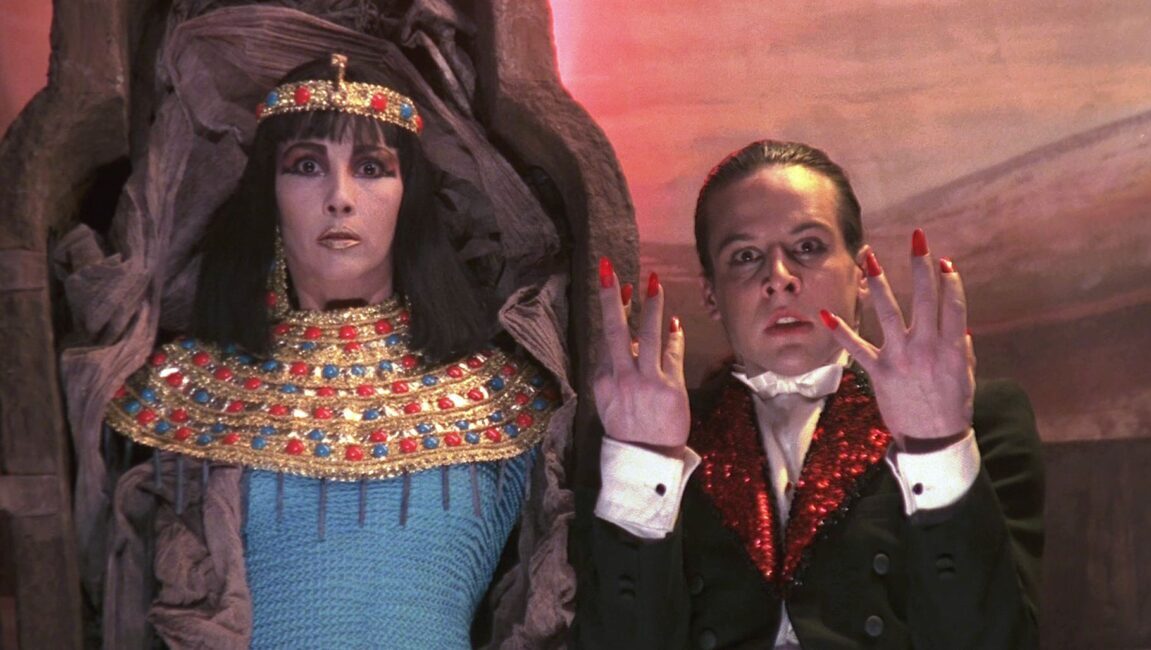A three-ring circus exhibiting acts of murder, mutilation, sexual frenzy, and religious fanaticism, Alejandro Jodorowsky’s Santa Sangre has a little something to perturb everyone. The story centers on serial murderer Fenix (Axel Jodorowsky), a young man burdened with a mother fixation unlikely enough to make even Norman Bates slap his brow in incredulity. Fenix’s odd obsession — triggered by one of the more traumatic celluloid childhoods this side of Bambi, and told in an extended flashback that occupies most of the first hour — compels him to lend a hand (or two) to the cabaret act of his armless mother, Concha (Blanca Guerra). A zealot for the cause of a maligned would-be saint who was raped and similarly disfigured, Concha espouses a rather dim view of feminine carnality, encouraging her son to develop into a real lady-killer.
But such bald description beggars the experience of viewing Santa Sangre for the first (or tenth) time. One element in its unsettling efficacy is the fact that the film represents one of those exceedingly rare birds: the seemingly seamless amalgamation of disparate cinematic sensibilities. Jodorowsky deploys the surrealist tendencies that made El Topo and The Holy Mountain midnight movie axioms. Disturbing dreams and hebephrenic hallucinations abound. Unmistakably Jodorowsky are the lurid carnivalesque strokes with which he limns Axel’s childhood, and the overarching atmosphere of febrile spirituality bordering on the hysterical-mystical finds numerous parallels in his early-‘70s films. Jodorowsky’s professed love of the monstrous expresses itself in a brilliant bit of self-reflexivity in a scene that invokes The Invisible Man as an exemplar of existential wish fulfillment. And, just as noticeably, there are aspects that can be laid at the doorstep of producer/cowriter Claudio Argento, with his experience working on the giallo films of older brother Dario, especially one superb set-piece shot from the killer’s POV, where the Steadicam-and-gel-lighting aesthetic could have been lifted directly from one of Dario’s candy-colored nightmares.
Though Jodorowsky tacks a quote from Scripture over the final, craning God’s-eye shot, there’s no abiding reason to suppose there will be any divine response to Axel’s cries from the depths of his all-too-human culpability.
At one point, Fenix’s mother contemptuously expresses the notion “You can’t atone for your sins with nightmares,” but, in its own idiosyncratic way, Santa Sangre attempts to do precisely that. The film eventually reveals itself as a philosophically amoral morality play concerned with “working through” guilt and accepting responsibility for one’s most heinous acts. As such, it enacts the inverse of Psycho, wherein Norman Bates ends up engulfed by the maternal-feminine. Then again, the psychology of Hitchcock’s film is unabashedly Freudian, even if its finale invites a parodic or subversive reading. Jodorowsky’s perspective seems far more Jungian: Fenix surrounds himself with archetypal projections ripped from the fabric of his delusions in an unconscious bid to regain a measure of self-determination. Ultimately, Fenix succeeds in vanquishing the baleful puritanical influence of his mother with the help of his “spirit guide” Alma (Sabrina Dennison), whose name, not coincidentally, means “soul” in Spanish. Though Jodorowsky tacks a quote from Scripture over the final, craning God’s-eye shot, there’s no abiding reason to suppose there will be any divine response to Axel’s cries from the depths of his all-too-human culpability.
Part of Kicking the Canon – The Film Canon.







